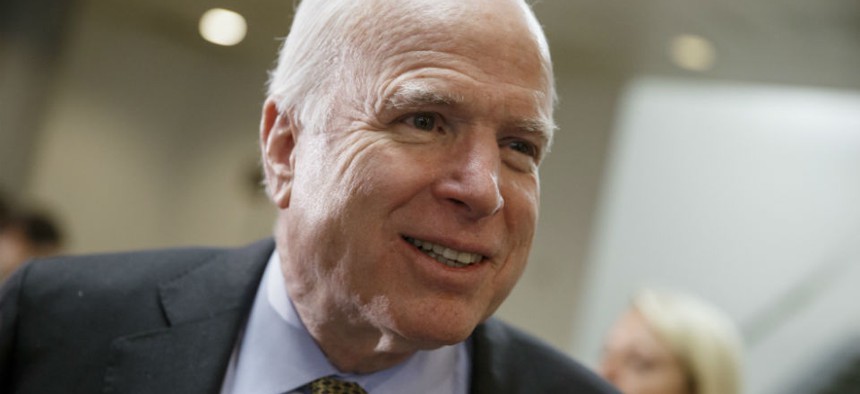John McCain Tells the Air Force to Fire More Civilians
Air Force defends its headquarters reduction efforts.
Sen. John McCain, R-Ariz., is very disappointed in the Air Force.
The cause of his frustration? The service, McCain said, is not firing enough civilian employees at its headquarters.
The Senate Armed Services Committee chairman complained in a letter to Air Force Secretary Deborah Lee James that the service’s boasts of reaching the staffing cuts required by then-Secretary Chuck Hagel more quickly than it expected were misleading. Rather than actually cutting positions by removing civilian workers from the payroll, the Air Force moved them to “subordinate headquarters,” McCain said.
Hagel’s 2013 memorandum required each service to reduce its headquarters spending by 20 percent. Follow-up guidelines written by Ashton Carter, then the deputy secretary of Defense, told the components to strive for a 20 percent reduction in civilian staff as part of those savings.
“The 20-percent headquarters reductions were meant to make Defense Department operations more efficient while saving money for American taxpayers,” McCain wrote. “But the conduct of the Air Force in response to this guidance seems to have produced no actual staff reductions and yielded no actual savings.”
An Air Force spokeswoman said the shifting around of positions was always part of the reduction plan, and the “subordinate headquarters” to which McCain referred are essential to the consolidation process.
“The Air Force will respond to Senator McCain's concerns as quickly as possible and looks forward to explaining its efforts in striving to meet the 20 percent management headquarters reduction,” the spokeswoman said. She added, however, the Air Force has provided congressional notifications of its plans throughout the process.
The service has not had to force anyone out, instead relying on voluntary incentives to get individuals to leave and then filling those positions with employees who otherwise would have been laid off.
In December, James announced the Air Force was walking away from a plan to lay off employees in 2015, saying the cuts were no longer necessary.
“We are in agreement. Enough is enough,” James said. “We have reduced far enough. We will not go lower, and we will fight to hold on to the numbers now that we have.”
The Air Force said it had decided to frontload its reduction efforts, despite having a five-year window to make the cuts per the Hagel order, to create more stability for its workforce. The Air Force is still offering voluntary separation incentives this year, such as early retirements, as it has done since the cuts began. So while the service has not “cut” any individuals per se, it has progressed toward its goal set last summer to eliminate 3,459 positions. This has allowed the Air Force to make the cuts in a less “draconian” way, the spokeswoman said.
McCain accused James of playing a “shell game” by shifting funds around, rather than making real cuts. He promised his committee will be “monitoring closely” the reductions going forward.
NEXT STORY: The United States Military Gets Childcare Right




